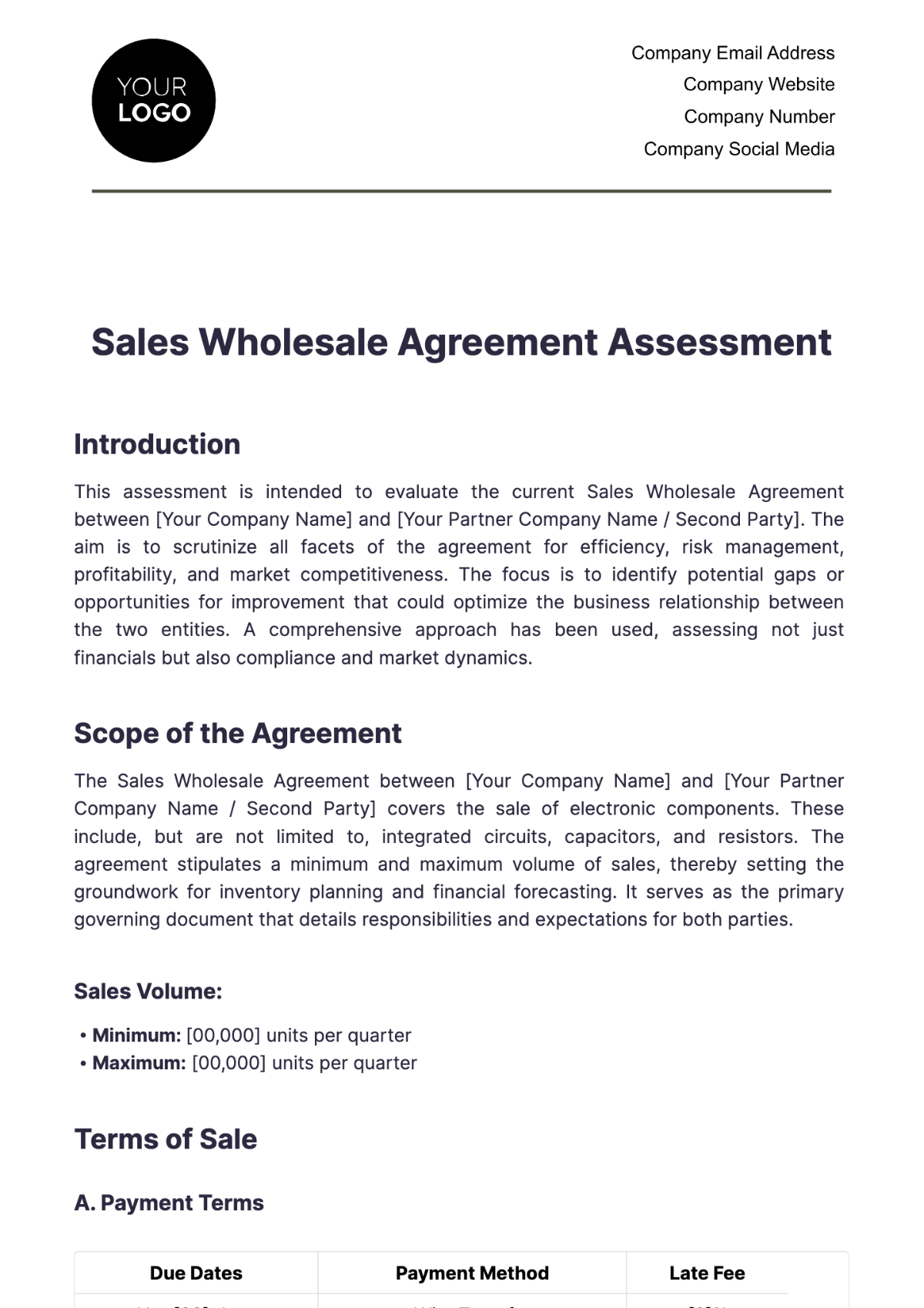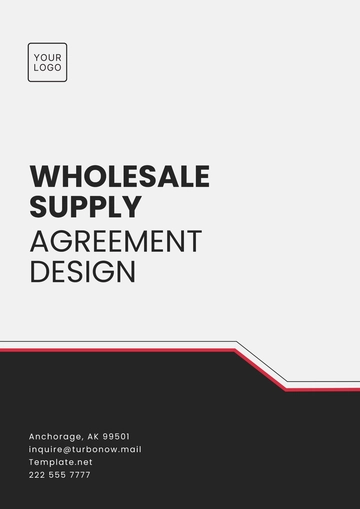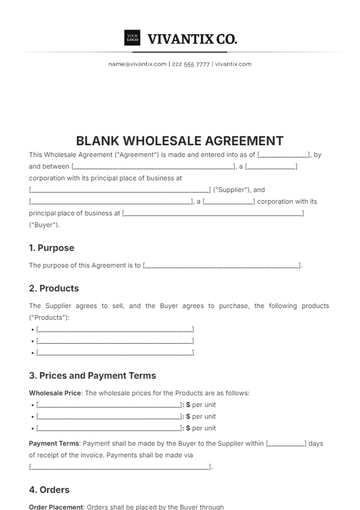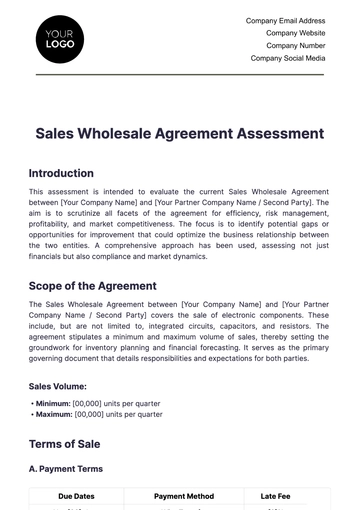Free Sales Wholesale Agreement Assessment

Introduction
This assessment is intended to evaluate the current Sales Wholesale Agreement between [Your Company Name] and [Your Partner Company Name / Second Party]. The aim is to scrutinize all facets of the agreement for efficiency, risk management, profitability, and market competitiveness. The focus is to identify potential gaps or opportunities for improvement that could optimize the business relationship between the two entities. A comprehensive approach has been used, assessing not just financials but also compliance and market dynamics.
Scope of the Agreement
The Sales Wholesale Agreement between [Your Company Name] and [Your Partner Company Name / Second Party] covers the sale of electronic components. These include, but are not limited to, integrated circuits, capacitors, and resistors. The agreement stipulates a minimum and maximum volume of sales, thereby setting the groundwork for inventory planning and financial forecasting. It serves as the primary governing document that details responsibilities and expectations for both parties.
Sales Volume:
Minimum: [00,000] units per quarter
Maximum: [00,000] units per quarter
Terms of Sale
A. Payment Terms
Due Dates | Payment Method | Late Fee |
Net [00] days | Wire Transfer | [0]% |
Payment terms are crucial to maintaining a smooth cash flow and are hence, an important part of the agreement. The standard Net [00] terms allow both parties ample time to manage their respective financial logistics.
B. Delivery Terms
Incoterms: FOB (Free On Board)
Location: [Your Company Address]
Lead Time: [0] weeks
Delivery terms set the stage for a predictable supply chain. Specifying the Incoterms as FOB ensures that the buyer takes responsibility for shipping costs and liabilities from our premises, thereby reducing our risks.
C. Return Policy
Returns are accepted within [00] days of the delivery date, subject to a [00]% restocking fee. This policy is aimed at providing some flexibility to the wholesale partner while protecting our interests through the restocking fee. This creates a balanced and fair approach to handling returns.
Risk and Compliance Analysis
A. Regulatory Compliance
FCC: All electronic components are FCC compliant.
RoHS: Products are RoHS compliant, ensuring no harmful substances are used.
Ensuring compliance with these regulations not only mitigates legal risks but also serves as a quality assurance measure for our wholesale partners. This strengthens our brand's reputation in the market.
B. Risk Mitigation
Supply Chain Risks: Secured multiple vendors for raw materials.
Legal Risks: All clauses within the agreement comply with federal and state laws.
Mitigating supply chain risks by securing multiple vendors adds a layer of security against unexpected disruptions. Ensuring that the agreement is legally sound also protects us from potential legal disputes.
Financial Assessment
A. Revenue Forecast
Quarter | Projected Sales Volume | Revenue |
Q1 205 | 12,000 units | $1,200,000 |
These projections are based on past performance and current market trends. A steady increase in sales volume is anticipated, providing promising revenue prospects for the coming fiscal year.
B. Profit Margins
Item | Cost | Sale Price | Profit Margin |
Integrated Circuits | $60 | $100 | 40% |
These profit margins have been calculated taking into account both direct and indirect costs. The data is crucial for understanding the financial viability of the products included in the agreement.
Market Analysis
Growth Rate: The market for electronic components is expected to grow by [0]% in the year [Year].
Competitor Pricing: Our main competitors have an average selling price [00]% higher than ours for similar products.
The market growth rate is an encouraging indicator of the potential for revenue expansion. Our pricing advantage over competitors positions us favorably in capturing a larger market share.
Recommendations
Introduce a dynamic pricing model to improve profit margins.
Update the return policy to include a [00]-day quick return with no restocking fees to incentivize larger orders.
These recommendations are targeted to address both the operational and financial aspects of the agreement. They are designed to offer tangible benefits that could lead to optimized profits and enhanced customer satisfaction.
Conclusion
The Sales Wholesale Agreement with [Your Partner Company Name / Second Party] demonstrates potential for high profitability and market competitiveness while adhering to compliance standards. However, minor tweaks are needed to optimize the agreement fully. Overall, with the strategic changes suggested in this assessment, there is an opportunity for a mutually beneficial and long-lasting business relationship between [Your Company Name] and [Your Partner Company Name / Second Party].
For further information or clarifications, please contact [Your Company Email] or visit [Your Company Website].
- 100% Customizable, free editor
- Access 1 Million+ Templates, photo’s & graphics
- Download or share as a template
- Click and replace photos, graphics, text, backgrounds
- Resize, crop, AI write & more
- Access advanced editor
Discover the ultimate solution for optimizing your wholesale agreements with Template.net's Sales Wholesale Agreement Assessment Template. Crafted with precision, this editable and customizable template offers unparalleled convenience. Seamlessly integrate data and insights using the AI Editor Tool, ensuring your agreements are fine-tuned for success. Elevate your business partnerships effortlessly with this indispensable tool.
You may also like
- Lease Agreement
- Non Compete Agreement
- Rental Agreement
- Prenuptial Agreement
- Non Disclosure Agreement
- Operating Agreement
- Hold Harmless Agreement
- LLC Operating Agreement
- Arbitration Agreement
- Purchase Agreement
- Residential Lease Agreement
- Executive Agreement
- Confidentiality Agreement
- Contractor Agreement
- Partnership Agreement
- Postnuptial Agreement
- Collective Bargaining Agreement
- Loan Agreement
- Roommate Agreement
- Commercial Lease Agreement
- Separation Agreement
- Cohabitation Agreement
- Room Rental Agreement
- Child Custody Agreement
- Employee Agreement
- License Agreements
- Settlement Agreement
- Joint Venture Agreement
- Indemnity Agreement
- Subordination Agreement
- Sales Agreement
- Agreements Between Two Parties
- Business Agreement
- Real Estate Agreement
- HR Agreement
- Service Agreement
- Property Agreement
- Agreement Letter
- Restaurant Agreement
- Construction Agreement
- Finance Agreement
- Marketing Agreement
- Payment Agreement
- Investment Agreement
- Management Agreement
- Nonprofit Agreement
- Software Agreement
- Startup Agreement
- Agency Agreement
- Copyright Agreement
- Collaboration Agreement
- Reseller Agreement
- Car Rental Agreement
- Cleaning Services Agreement
- Consultant Agreement
- Deed Agreement
- Car Agreement
- Equipment Agreement
- Shares Agreement
- Data Sharing Agreement
- Advertising Agreement
- School Agreement
- Franchise Agreement
- Event Agreement
- Travel Agency Agreement
- Vehicle Agreement
- Board Resolution Agreement
- Land Agreement
- Binding Agreement
- Tenancy Agreement
- Exclusive Agreement
- Development Agreement
- Assignment Agreement
- Design Agreement
- Equity Agreement
- Mortgage Agreement
- Purchase and Sale Agreement
- Shareholder Agreement
- Vendor Agreement
- Royalty Agreement
- Vehicle Lease Agreement
- Hotel Agreement
- Tenant Agreement
- Artist Agreement
- Commission Agreement
- Consignment Agreement
- Debt Agreement
- Recruitment Agreement
- Training Agreement
- Transfer Agreement
- Apprenticeship Agreement
- IT and Software Agreement
- Referral Agreement
- Resolution Agreement
- Waiver Agreement
- Consent Agreement
- Partner Agreement
- Social Media Agreement
- Customer Agreement
- Credit Agreement
- Supply Agreement
- Agent Agreement
- Brand Agreement
- Law Firm Agreement
- Maintenance Agreement
- Mutual Agreement
- Retail Agreement
- Deposit Agreement
- Land Purchase Agreement
- Nursing Home Agreement
- Supplier Agreement
- Buy Sell Agreement
- Child Support Agreement
- Landlord Agreement
- Payment Plan Agreement
- Release Agreement
- Research Agreement
- Sponsorship Agreement
- Buyout Agreement
- Equipment Rental Agreement
- Farm Agreement
- Manufacturing Agreement
- Strategic Agreement
- Termination of Lease Agreement
- Compliance Agreement
- Family Agreement
- Interior Design Agreement
- Ownership Agreement
- Residential Lease Agreement
- Retainer Agreement
- Trade Agreement
- University Agreement
- Broker Agreement
- Dissolution Agreement
- Funding Agreement
- Hosting Agreement
- Investor Agreement
- Memorandum of Agreement
- Advisory Agreement
- Affiliate Agreement
- Freelancer Agreement
- Grant Agreement
- Master Service Agreement
- Parking Agreement
- Subscription Agreement
- Trust Agreement
- Cancellation Agreement
- Horse Agreement
- Influencer Agreement
- Membership Agreement
- Vacation Rental Agreement
- Wholesale Agreement
- Author Agreement
- Distributor Agreement
- Exchange Agreement
- Food Agreement
- Guarantee Agreement
- Installment Agreement
- Internship Agreement
- Music Agreement
- Severance Agreement
- Software Development Agreement
- Storage Agreement
- Facility Agreement
- Intercompany Agreement
- Lending Agreement
- Lodger Agreement
- Outsourcing Services Agreement
- Usage Agreement
- Assurance Agreement
- Photography Agreement
- Profit Sharing Agreement
- Relationship Agreement
- Rent To Own Agreement
- Repayment Agreement
- Volunteer Agreement
- Co Parenting Agreement
- HVAC Agreement
- Lawn Care Agreement
- SAAS Agreement
- Work from Home Agreement
- Coaching Agreement
- Protection Agreement
- Security Agreement
- Repair Agreement
- Agreements License



